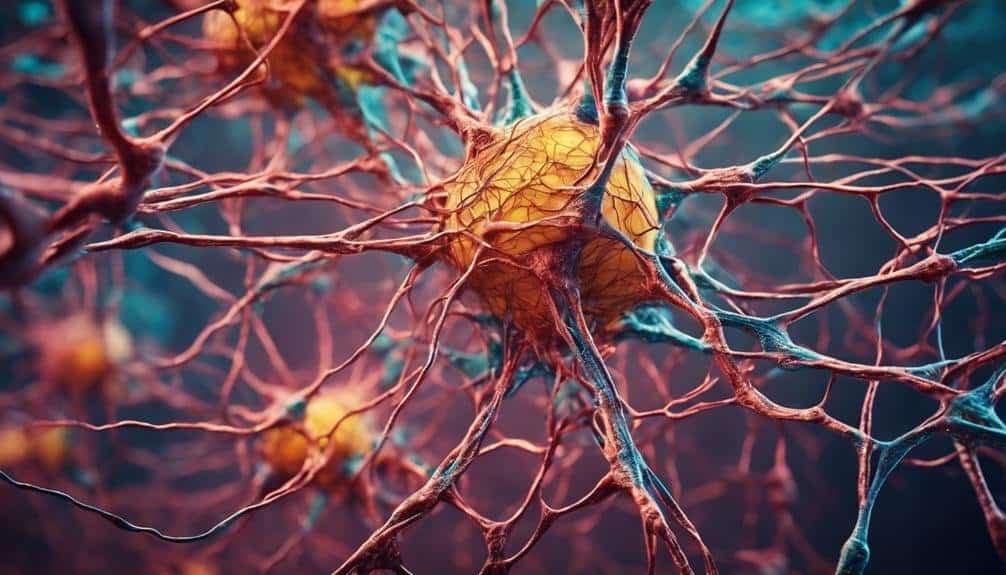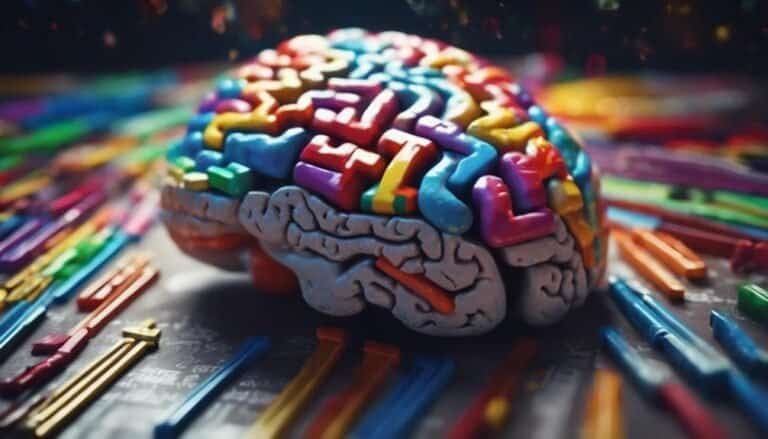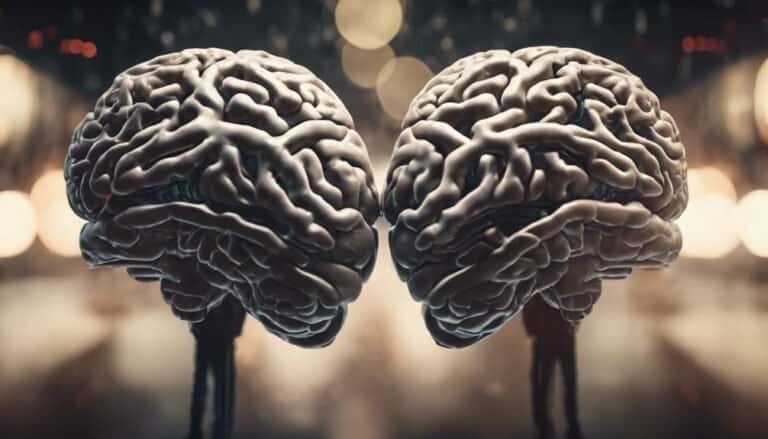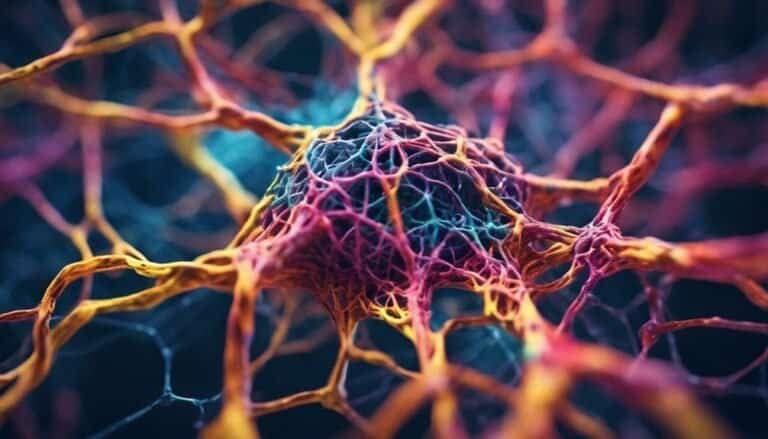Brain's Adaptation to Change
Imagine your brain as a complex network of pathways, constantly adjusting and evolving in response to the world around you.
But how exactly does this remarkable organ adapt to the ever-changing environment? Understanding the brain's ability to rewire itself in the face of challenges offers a fascinating insight into human resilience and growth.
Explore the intricate mechanisms behind neuroplasticity and cognitive flexibility that enable you to navigate life's twists and turns with grace and strength.
Key Takeaways
- Neuroplasticity enables brain to adapt to new challenges and learn new skills.
- Cognitive flexibility fosters adaptive responses to changing environments.
- Resilience relies on neural networks adjusting to bounce back from adversity.
- Embracing a growth mindset enhances learning agility for lifelong adaptability.
Neuroplasticity: The Brain's Adaptive Power
Neuroplasticity, the brain's remarkable ability to reorganize itself by forming new neural connections, plays a crucial role in adapting to change. This process of brain rewiring is essential for adaptability, allowing individuals to learn new skills, recover from injuries, and adjust to different environments. Neuroplasticity benefits encompass a spectrum of functions, from cognitive development in children to recovery from strokes in adults. The brain's capacity for growth through neuroplasticity is evident in studies showing how learning a new language or acquiring a new skill can lead to structural changes in the brain.
Research indicates that neuroplasticity isn't limited to specific ages but is a lifelong phenomenon. It highlights the importance of continuous learning and cognitive stimulation to promote neural connections and maintain brain health. By understanding the mechanisms behind neuroplasticity, individuals can harness this ability to adapt more effectively to changing circumstances and enhance their overall cognitive functioning.
Cognitive Flexibility: Embracing Change
Embracing change requires a cognitive flexibility that allows for adaptive responses to evolving circumstances. Cognitive agility, the ability to make quick mental shifts, plays a crucial role in navigating uncertain terrain. When faced with changes, cultivating an adaptive mindset becomes essential for effectively processing new information and adjusting behaviors accordingly. Research suggests that individuals who embrace uncertainty tend to exhibit higher levels of resilience and overall psychological well-being. By fostering cognitive flexibility, you can enhance your capacity to embrace change with a more open and adaptable approach.
Studies on cognitive flexibility highlight its significance in various aspects of life, from problem-solving to decision-making. This ability enables individuals to adjust their thinking patterns and behaviors in response to novel situations, fostering a more proactive stance towards change. Embracing an adaptive mindset not only enhances your ability to cope with uncertainty but also promotes personal growth and development. Therefore, cultivating cognitive flexibility is key to successfully navigating the ever-changing landscape of life.
Neural Networks: Rewiring for Resilience
As you explore the concept of neural networks rewiring for resilience, you'll uncover the intricate mechanisms of neural plasticity that underlie this adaptive process.
Understanding how neural networks adapt and reorganize themselves can shed light on the brain's remarkable ability to bounce back from challenges.
Research indicates that resilience through adaptation involves a complex interplay of synaptic connections and neural circuitry adjustments.
Neural Plasticity Mechanisms
The brain's ability to adapt to change through neural plasticity mechanisms is a fundamental aspect of its resilience and capacity for rewiring neural networks. Synaptic connections play a crucial role in brain plasticity, allowing for the formation of new connections and the pruning of unnecessary ones.
Cognitive restructuring, a process closely tied to neural adaptation, involves the brain's ability to reorganize neural pathways in response to new experiences or challenges. Through these mechanisms, the brain can adjust its structure and function, optimizing its performance in different contexts.
Neural plasticity enables the brain to learn, memorize, and adapt, providing a foundation for resilience in the face of changing environments and circumstances. This adaptability underscores the brain's remarkable capacity for growth and transformation.
Resilience Through Adaptation
Adapting to change in the brain involves a dynamic process of rewiring neural networks for resilience. This emphasizes the brain's capacity for transformation and growth. Mental toughness and a growth mindset are key components in this process. Neural plasticity enables individuals to adapt gracefully and bounce back from challenges. Research shows that individuals with a growth mindset are more likely to view obstacles as opportunities for growth, leading to enhanced resilience.
Learning Agility: Thriving in Flux
You must adapt to the ever-changing landscape of information and experiences by cultivating learning agility.
Embracing constant change and fostering flexibility in learning are essential components of thriving in a dynamic environment.
Research suggests that those who exhibit learning agility have a higher likelihood of success in navigating flux and uncertainty.
Flexibility in Learning
Navigating through a rapidly changing world demands a high level of learning agility to thrive in constant flux. Flexibility in learning is crucial for adapting to new situations and acquiring new skills efficiently. Here are three key aspects to consider:
- Continuous Skill Development: Embracing a growth mindset and engaging with educational innovations are essential for staying relevant in a dynamic environment.
- Adaptive Strategies: Employing adaptive strategies allows for quick adjustments to changing circumstances, enabling effective problem-solving and decision-making.
- Lifelong Learning: Committing to lifelong learning ensures that you're equipped with the latest knowledge and tools needed to succeed in a constantly evolving landscape.
Embracing Constant Change
Flexibility in learning plays a pivotal role in fostering adaptability to constant change, a cornerstone of thriving in today's dynamic environment.
Mindful acceptance and personal growth are key components of embracing constant change. Research shows that individuals who approach change with a positive mindset tend to navigate uncertainty more effectively.
By cultivating a mindset that welcomes new challenges as opportunities for growth, you can enhance your learning agility and resilience in the face of constant flux.
Embracing uncertainty not only allows for greater adaptability but also opens doors to new possibilities and experiences.
Emotional Adaptation: Navigating Uncertainty
In the realm of emotional adaptation, the brain undergoes intricate processes to navigate the uncertainties that arise. When faced with the unknown, your brain engages in sophisticated mechanisms to manage emotional regulation and uncertainty effectively.
- Emotional Regulation: Your brain utilizes various neural pathways to regulate emotions, ensuring that you can cope with the uncertainty in a balanced manner.
- Coping Strategies: Through the activation of specific brain regions, such as the prefrontal cortex, you develop coping strategies to navigate uncertainty, fostering resilience and emotional well-being.
- Adaptive Mindset: By fostering an adaptive mindset, your brain rewires itself to embrace change positively, enabling you to approach uncertainties with openness and flexibility.
These processes showcase the brain's remarkable ability to adapt emotionally, allowing you to navigate uncertain situations with resilience and emotional intelligence.
Stress Response: Coping Mechanisms
Utilizing adaptive coping mechanisms, the brain responds to stress by engaging in intricate physiological and cognitive processes to restore equilibrium. Stress management plays a crucial role in maintaining overall well-being. Coping strategies, such as mindfulness techniques, can aid in navigating stressful situations effectively. When faced with stressors, practicing self-care and mindfulness can help regulate the body's stress response.
Engaging in activities that promote relaxation, such as deep breathing exercises or meditation, can assist in reducing stress levels. By incorporating coping mechanisms like mindfulness, individuals can enhance their ability to cope with challenging circumstances. Mindfulness involves focusing on the present moment without judgment, which can help alleviate stress and promote mental clarity.
Incorporating self-care practices into daily routines is essential for managing stress effectively. Taking time for activities that bring joy or relaxation can contribute to a more balanced stress response. By prioritizing stress management and implementing coping strategies like mindfulness and self-care, individuals can better navigate the challenges that come their way.
Environmental Influence: Shaping Brain Changes
Environmental factors play a significant role in shaping changes within the brain's structure and function. The brain's plasticity, or its ability to reorganize itself by forming new neural connections, is heavily influenced by external factors.
Here are three key ways in which environmental influences impact brain changes:
- Brain Plasticity: Environmental factors such as education, social interactions, and experiences can induce changes in the brain's neural pathways. For example, learning a new skill can lead to the formation of new connections between neurons, enhancing cognitive abilities.
- Cognitive Adaptability: The brain's ability to adapt to new environments and challenges is crucial for cognitive adaptability. Exposure to diverse environments, novel stimuli, and varying levels of stress can shape the brain's capacity to adjust and learn.
- External Influences: Factors like nutrition, physical activity, and exposure to toxins also play a role in shaping brain changes. A healthy diet and regular exercise, for instance, can support optimal brain function, while exposure to environmental toxins can have detrimental effects on neural development.
Conclusion
In conclusion, your brain is like a resilient tree bending in the wind of change. Through neuroplasticity, cognitive flexibility, and learning agility, it adapts and grows stronger.
Just as roots anchor the tree, neural networks rewire for resilience, enabling you to thrive in flux.
Embrace emotional adaptation and navigate uncertainty like branches swaying in the storm. Remember, like the tree, your brain's ability to adapt is key to weathering life's challenges and flourishing in new environments.







